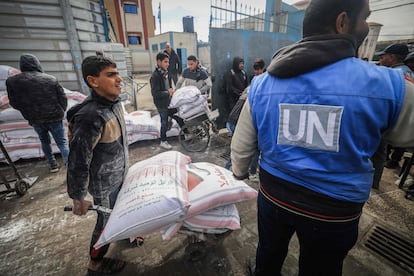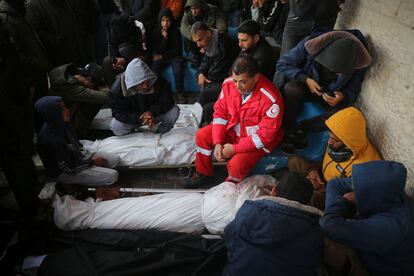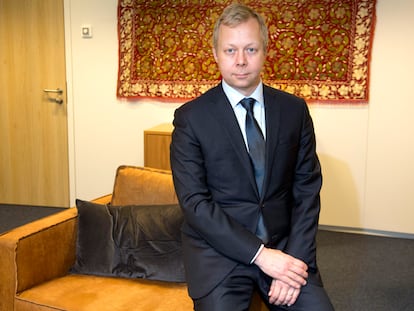The Palestinian ‘heroes’ who support humanitarian aid in Gaza
UNRWA and other UN agencies, together with international and local NGOs, provide and coordinate assistance through mostly local staff


Fidaa al Araj lives clinging on to what she calls “a thread of hope”. With her six children, aged three to 15, her husband and her in-laws, she has already been displaced four times since the Gaza war began: 10 people now crammed into a single room in southern Rafah, a roof over her head for which she says she is fortunate. Rafah’s population, before the war about 250,000 people, has grown sixfold with displaced people trying to find a safe haven that no longer exists in the Strip. Palestinians who once had a life now survive under plastic sheeting on the streets, according to the Health Ministry of the Hamas-ruled territory. The 39-year-old psychologist struggles every day to find food and water for her family, and to avoid giving in to the fear that, because of her work, she will become a target as was probably the case with at least some of the 196 humanitarian workers killed so far in the conflict. Juliette Touma, Director of Communications for the United Nations agency for Palestinian refugees (UNRWA), calls them “heroes.”
Al Araj is the Food Security, Cash and Protection coordinator for the NGO Oxfam, whose 26 employees in Gaza are now, without exception, Palestinians, she tells EL PAÍS by telephone. Two months ago, she and her colleagues managed to set up an office in Rafah, where they continue to manage the NGO’s work, in collaboration with Oxfam’s international offices. “We have never stopped working,” says the aid worker, who estimates that her organization’s humanitarian assistance since November has benefited at least 200,000 people, almost 10% of the Gazan population. They have distributed food, materials for shelter, blankets, mattresses, and hygiene items. They have also installed one of their organization’s specialties — latrines and showers — in the refugee camps for people displaced by the war.
Al Araj’s profile is not an unusual one. As in most places that rely on humanitarian aid, in Gaza the bulk of relief workers are locals. Another example is provided by Doctors Without Borders. Sources in this NGO point out that, in their case, the ratio is nine Gazans for every foreigner, while Julie Mehigan, programme manager in the occupied Palestinian territories for Christian Aid, states by mail that “99%-100%” of people working with them in the Strip are Palestinians.
This reality breaks with the myth of the white savior, which alludes to the cliché that identifies aid workers with Caucasian males from rich countries. The media and diplomatic impact of events such as the death in an Israeli attack of six Western humanitarians from the NGO World Central Kitchen (WCK) last Monday contributes to reinforce this stereotype. Only those six humanitarians, out of the total 196 who have died in the war, were expatriates.
The Palestinian aid workers whose deaths went almost unnoticed also perished “while carrying out their duty to provide humanitarian aid,” recalls the UNRWA Director of Communications from Jordan. Of the nearly 200 victims, 177 worked for the United Nations agency. “Our colleagues maintain this noble commitment to their people when they themselves are victims of war: they have been displaced, they have lost their homes and their loved ones, but they continue their work because they feel it is their duty,” says Touma.
UNRWA is the main humanitarian actor in Gaza and has the most infrastructure: buildings, vehicles, warehouses and, above all, personnel. Its 13,000 employees are more than the combined workforce of all the other organizations present in the enclave. Most of them are teachers in the agency’s 183 schools, in which nearly 300,000 children study. These schools and other UNRWA facilities now house some 1.7 million displaced people and classes have stopped. As a result, only 4,000 employees of UNRWA, which also has 22 health centers in the Strip, are still active. These are doctors, nurses, midwives, drivers or those who deliver the flour that 1.8 million people have relied on since November. Only 25 to 30 of its aid workers in Gaza are foreigners.
The enormous weight of this institution makes humanitarian aid in Gaza unique. UNRWA is unique. No other UN agency focuses specifically on a particular refugee population. Martin Griffiths, UN Under-Secretary General for Humanitarian Affairs, defines it as “the backbone” of assistance in the territory.
“There is no other humanitarian actor in Gaza that can provide food, water, and medicine on the scale that UNRWA does,” Matthew Miller, spokesman for the U.S. State Department, Israel’s staunchest ally, said in February. The Israeli authorities profess an avowed aversion to the agency and make no secret of its intention to do away with it. Despite the growing weight of the now suspended work of World Central Kitchen, UNRWA and the other 22 United Nations agencies in Gaza — UNICEF, the World Food Program and the World Health Organization among them — have provided 80% of the humanitarian assistance dispensed in the six months of war in the Strip, according to data from the Israeli government itself.

“Palestinian lives deserve to be mourned just as much as any other life”
Around 70 international NGOs are also assisting the Gazan population, according to a calculation by this newspaper based on public and United Nations information. The UN organizes humanitarian assistance with these organizations through what are called clusters or sectors. There are six: education, food security, health and nutrition, protection, shelter, and water, sanitation and hygiene (WASH).
Fidaa Al Araj’s NGO, Oxfam, co-leads the WASH sector with UNICEF. An example of their coordination work would be to prevent two organizations from installing latrines in the same refugee camp and leaving others without them. None of these sectors, the aid worker explains from Rafah, has stopped working because of the war.
In addition to Oxfam, other important international NGOs are present in Gaza: Doctors Without Borders, International Rescue Committee, Doctors of the World, the Norwegian Refugee Council, Action Against Hunger, Care International, Save the Children, Anera and Christian Aid, among others, in addition to many local NGOs, which collaborate with them and with the UN.
A legion of Gazan volunteers in turn supports the humanitarian work in the Strip. The NGO Anera alone has 400, according to its president, Sean Carroll. Some of the 11 Palestine Red Crescent Society workers killed since October 7 were volunteers. Others were employees, such as Yusuf Zeino and Ahmed al-Madhoun, who died trying to rescue a six-year-old girl called Hind. As with WCK on Monday, their ambulance was hit with a missile. It was also carrying identifying marks and the Israeli authorities had been alerted to their route. No one has apologized for these deaths, nor has Israel come under public pressure to investigate them.
“We appreciate all the aid workers who were killed while trying to help us in Gaza,” a tweet from Palestinian journalist Hossam Shabat said Saturday. It continued, “But our lives matter as much as theirs do [...] Palestinian lives deserve to be mourned just as much as any other life.”
Aside from journalism, almost every day we cook meals to feed the displaced in schools in North Gaza. With our very limited supplies, we cook and distribute meals to hundreds every day. We appreciate all the aid workers who were killed while trying to help us in Gaza, but our… pic.twitter.com/h0vPNVysxu
— حسام شبات (@HossamShabat) April 6, 2024
Sign up for our weekly newsletter to get more English-language news coverage from EL PAÍS USA Edition
Tu suscripción se está usando en otro dispositivo
¿Quieres añadir otro usuario a tu suscripción?
Si continúas leyendo en este dispositivo, no se podrá leer en el otro.
FlechaTu suscripción se está usando en otro dispositivo y solo puedes acceder a EL PAÍS desde un dispositivo a la vez.
Si quieres compartir tu cuenta, cambia tu suscripción a la modalidad Premium, así podrás añadir otro usuario. Cada uno accederá con su propia cuenta de email, lo que os permitirá personalizar vuestra experiencia en EL PAÍS.
¿Tienes una suscripción de empresa? Accede aquí para contratar más cuentas.
En el caso de no saber quién está usando tu cuenta, te recomendamos cambiar tu contraseña aquí.
Si decides continuar compartiendo tu cuenta, este mensaje se mostrará en tu dispositivo y en el de la otra persona que está usando tu cuenta de forma indefinida, afectando a tu experiencia de lectura. Puedes consultar aquí los términos y condiciones de la suscripción digital.
More information
Archived In
Últimas noticias
Welcome to the post-religion era: The idea of Christianity as the absolute truth has become obsolete
‘I thought you would like it’: The risky sexual practice popularized by TV shows and TikTok
The digitalization of tourism: ‘They promise experiences and gave us the worst possible one’
Mexican peso defies uncertainty with forecasts of a new period of stability in 2026
Most viewed
- Sinaloa Cartel war is taking its toll on Los Chapitos
- Reinhard Genzel, Nobel laureate in physics: ‘One-minute videos will never give you the truth’
- Oona Chaplin: ‘I told James Cameron that I was living in a treehouse and starting a permaculture project with a friend’
- Why the price of coffee has skyrocketed: from Brazilian plantations to specialty coffee houses
- Silver prices are going crazy: This is what’s fueling the rally









































